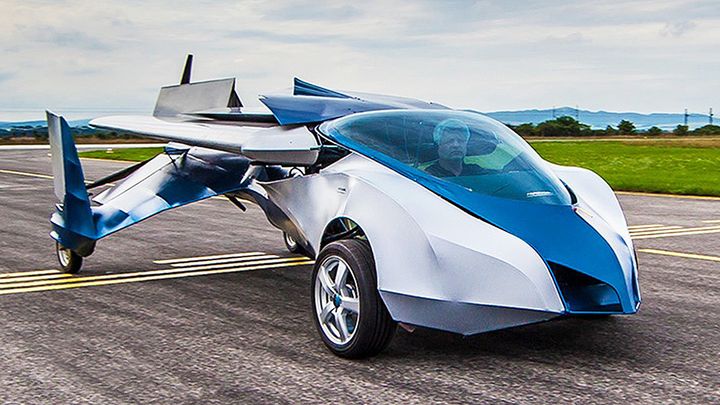"What the hell is a gigawatt?" -- Marty McFly

Our world is changing more and more each day. The science fiction and wishful thinking of yester-year is rapidly becoming the reality we take for granted.
Entrepreneurs, engineers, and inventors are all busy building a world in which technology sinks its roots, deep into our daily lives, enabling lightning fast access to a worldwide repository of information and empowering us to reach further than ever before.
Let’s take a look at 8 real life examples that show us we “metaphorically" are living in the future.

Space Vacations...Literally, in Space
Imagine a world in the not-too-distant future where you’re planning a family vacation amongst the stars. You browse the list of available flights, trying to decide which exotic locale it will be this year. The moons of Jupiter, perhaps? Or maybe you’ll book a flight back to Venus again—the sunsets from the city floating among the toxic clouds simply cannot be rivaled anywhere else in this “Local Galactic Group”.
All made possible thanks to the money and manpower of far-seeing Earth based companies who made affordable and efficient spaceflight a priority many years before. It may sound like the beginning of a sci-fi novel, but companies like SpaceX, Blue Origin and Virgin Galactic are working to turn it into a reality.
The world of privatized spaceflight was rocked by spectacular news in November of 2015, with entrepreneur Elon Musk’s brainchild SpaceX, landing a deal to become the interstellar Uber for NASA astronauts, wanting to reach the International Space Station. This is especially big news, as pending successful test runs by SpaceX, NASA will no longer be required to rely upon their Russian counterparts toferry them to and from low earth orbit. They hope to begin crewed spaceflights in SpaceX’s luxurious Crew Dragon spacecraft by 2017. Jeff Bezos’ company Blue Origin has been giving SpaceX a run for their money of late, in the race to produce the first fully reusable rocket—a massive achievement in the space business, as reusable rockets will dramatically cut costs to put people into orbit. There has been some friendly sparring over social media between Musk and Bezos, after Blue Origin claimed to be the first to reach orbit with a rocket which landed safely after its ascent. Regardless of who’s right in the end, ultimately it’s space agencies, all across the world that will certainly be the ones who win from such fierce competition.
Even aviation giant Boeing is joining in on the orbital fun, having recently unveiled their own craft, the “Starliner”. Also under contract with NASA, Boeing hopes to position the Starliner as a replacement, so the agency no longer has to rely upon the Russian Soyuz craft. For the first time, NASA will have plenty of choices when it comes to choosing their next vehicle for space travel.
Meanwhile, Richard Branson and the folks at Virgin Galactic, are hard at work making space accessible to the masses. They seek to stake a claim in the space tourism business, setting their sights a little lower than their peers, but with the hopes that additional public exposure to space will benefit the entire private spaceflight industry. Sure, they’ve had some significant setbacks in their quest, but Branson and his team doggedly continue to chase their dream. Between Boeing, Virgin Galactic, SpaceX, and Blue Origin, it’s not a matter of “if” the private sector will help to usher in a new age of prosperity in spaceflight, but when. Nothing drives progress like competition, especially when money is involved. And when these companies do achieve their goals, eventually the opportunity will come for every one of us to experience the vast reaches of outer space, first hand.
Where there are spaceships in science fiction, there are powerful drive cores that enable the physics defying, faster-than-light travel, necessary to bring galaxies together, and enable the exploration of strange new worlds.
Warp drives were once little more than wishful thinking on the part of artistic visionaries, but recently NASA announced an experimental Electro-Magnetic Drive that, if proven to be science fact, could very well be the breakthrough, aspiring space pioneers have been waiting for. Despite being a theoretical impossibility—a fact which skeptics are quick to point out—NASA’s experimental EM Drive continues to pass volleys of tests that seem to prove it is actually producing thrust. The science behind the EM Drive involves pushing microwaves into a closed cone from the large end to the smaller end, which seems to be producing minute measures of thrust, through processes no one is quite certain about. In essence, the drive becomes a propellant-less propulsion system. The thrust is barely even measurable at the moment, but breaking the laws of physics simply can’t be rushed.
A functional EM Drive would cut down the trip to Mars from many months to a little over two. In addition, it would only need a relatively small amount of power to operate—something that current technology would be more than capable of providing. But for all this wishful thinking, there is one inescapable truth about the drive NASA is struggling to figure out—it doesn’t abide by known universal truths.
Possible flaws in the experiment are still being ferreted out, with the system showing noteworthy amounts of thermal expansion that could be skewing the results, but the researchers assert that despite the potential vectors for failure, the EM Drive continues to produce “anomalous thrust signals”. And if there’s one thing scientists like, it’s a good anomaly in data sets.
Propulsion systems like the EM Drive will prove to be critical pieces of equipment in long-term space ventures, such as a trip to Mars or beyond, as they reduce or completely mitigate the need for fuel and the weight that it adds to the vessel. Unfortunately, however, despite the tentative success of the EM Drive, NASA asserts that it is not in fact working on anything like “warp” technology. Which means that we won’t be venturing out of our solar system anytime soon, but hey, there’s still plenty we have yet to explore in our own interstellar neighborhood.

Everything, Connected
Perhaps you’ve always wanted to live the life of a cyborg. Forever connected to the tangled web of computers and digital devices that crisscrosses our world. But lugging around an unwieldy laptop is often more trouble than it’s worth.
That’s why innovators and engineers have spent the last two decades finding novel ways to fit the full experience right in your pocket. Never miss a moment on social media, work on the go, or get a little exercise—wearable computers are here to keep you plugged in.
For better or for worse. Thanks to “the cloud”—otherwise known as the seemingly omnipresent server bank in the sky—anything we can do on one electronic device can be sent to all our other devices at the push of a button. Start a project on your tablet, and pick up where you left off on your desktop when you get home. Take pictures with a cloud-connected camera, and you’ll find them ready to edit on your laptop in moments. All of this requires an internet connection, but that single lifeline tethers all of your devices into a single, thriving ecosystem of interconnectivity and accessibility the likes of which has never been seen before. An entire industry has been built around cloud-based backups, meaning you never have to worry about losing your precious puppy photos ever again.
Every major player in the computing world today has developed their own form of speech recognition, and for good reason. As devices get smaller, it becomes less and less convenient to mash away on a virtual keyboard while writing your magnum opus or searching for cat videos. And if there’s one thing that Star Trek has taught us, it’s that the future is a friendly and omniscient computer that we can query at our leisure. When combined with the power of the cloud, voice recognition ensures that any of your questions can be answered—and your all-important spreadsheets for that meeting can be found, wherever you are—with a simple voice command to a wrist-mounted computer.

Driverless World
Who hasn’t had a moment behind the wheel of a car that made them wish for their very own valet? Maybe you’ve had too much to drink, maybe you’re tired, or you just can’t get your head out of a book you’re reading– sometimes life would be so much more convenient if cars could get from A to B without any input on our part. But it’s not easy building a car that can steer itself—the roadways of the world are wild and dangerous places, fraught with perils and hazards that can challenge even the most defensive of drivers. Could a computer really take the place of a person, behind the wheel? More importantly, should it?
No matter your opinion on the subject, thanks to the hard work and capital of companies like Google and Tesla, self-driving cars could be sharing the road with you a lot sooner than you think. They say you need 10,000 hours in any subject to become an expert in it, but I’m not certain whether or not that applies to computers as well. Since Google began testing their self-driving cars, they’ve logged over 1.2 million miles of autonomous driving, equating to almost a century of human experience behind the wheel.
And during each and every one of those trial miles, the Google test vehicles never exceeded 25 miles per hour for safety reasons. So if you’re a bit of a petrol head, this technology isn’t for you. According to Google, who may in fact have a particular bias when it comes to this subject, the autonomous car will be one of the safest ways to travel. Fortunately, they have some data to back up their claim. And during each and every one of those trial miles, the Google test vehicles never exceeded 25 miles per hour for safety reasons. So if you’re a bit of a petrol head, this technology isn’t for you. According to Google, who may in fact have a particular bias when it comes to this subject, the autonomous car will be one of the safest ways to travel. Fortunately, they have some data to back up their claim.
Out of all the collisions suffered by the self-driving vehicles, all of them were caused by a human. Whether a human driving another vehicle or the Google engineer assuming direct control of the test vehicle. It seems Google is slowly trying to render humans obsolete. An equally exciting and scary notion.Out of all the collisions suffered by the self-driving vehicles, all of them were caused by a human. Whether a human driving another vehicle or the Google engineer assuming direct control of the test vehicle. It seems Google is slowly trying to render humans obsolete. An equally exciting and scary notion.
Tesla has been seeing success on the robotic driver front as well, pushing wireless software updates to their cars which add limited Autopilot functionality. For now, Tesla intends for Autopilot to be a sort of cruise control plus—still requiring human intervention, but taking a bit of the busywork out of freeway driving and other straight and simple roads. And Elon Musk isn’t a man to leave a project half-finished. It’s only a matter of time before Tesla is giving Google a run for its money. Tesla has been seeing success on the robotic driver front as well, pushing wireless software updates to their cars which add limited Autopilot functionality. For now, Tesla intends for Autopilot to be a sort of cruise control plus—still requiring human intervention, but taking a bit of the busywork out of freeway driving and other straight and simple roads. And Elon Musk isn’t a man to leave a project half-finished. It’s only a matter of time before Tesla is giving Google a run for its money.

Flying Cars...Finally
So that’s it for earthbound robo-cars, but what about the future promised to us by mid-20th century sci-fi? Where’s on Earth are the flying cars? Fortunately, someone’s thought of that too. According to CNN Money, many small companies are jockeying for position to be the first to bring hovercars to the masses. As with privatized spaceflight, it seems that the true innovation may rest in the hands of the little guys. Like self-driving cars, legislation has proven to be the biggest obstacle to overcome, but once they can cut through the red tape, prototyping an entirely new form of travel shouldn’t be that hard, the technology is already there to make flying cars a reality.

Cloaking...Yes, Cloaking
For any budding criminals out there having an invisibility cloak on hand is an absolute necessity. It simply wouldn’t do to have a well-orchestrated caper fall apart on account of your cloaking device failing, would it now? Luckily for mischievous individuals, living in our current day and age means that they have access to all manner of new and exciting ways to make things disappear. There are several different approaches that scientists use to effectively hide an object from view. One technique involves bending light to mask the object in question, but unfortunately this particular technique isn’t quite ready for a full-scale prototype yet. Another method is to render an object virtually transparent to microwaves by using metamaterials, which are basically lab-made materials not found in nature, to prevent the waves from scattering, after contacting the object in question. Though the effect created by these metamaterials isn’t quite transparent enough, yet. Another approach to invisibility is making something so dark that the human eye can’t actually see it. The National Physical Laboratory in the UK have recently invented the darkest material known to man.
Called Vantablack, it is darker than the blackest of blacks, it’s so dark in fact that almost no light can escape it, it absorbs 99.965% of photons that hit it. It is made from carbon nanotubes that trap any light that hits them. It’s so dark that you can’t even see how dark it is right now, because your computer monitor is not capable of reproducing such a dark black. If you cover any object with Vantablack it immediately removes any “3Dness” from it, turning it into a completely 2D splodge. It’s currently being ordered in vast quantities by the military, who are suspected of planning to use it to cloak military aircraft and naval vessels. Scientists have even turned to replicating natural phenomena in their quest to create a real cloak of invisibility. No doubt, on a particularly hot summer’s day, you will have noticed what appeared to be a pool of water just ahead of you on asphalt or sand. This effect is an optical illusion called a mirage, that’s created when light is refracted as it passes through hot air. This inspired techno-wizards to design a cloaking device made up of electrically stimulated nanotubes. When a current is passed through them, the nanotubes bend light away from the object they are covering, creating an artificial sort of mirage, that causes the object to disappear from view. Not exactly the most subtle cloaking effect, but like the others, it’s a start.

Telekinesis? Yes, please.
If you’ve ever fancied grabbing ahold of something or even moving it without actually touching it, then you’re in luck—tractor beams aren’t just for starship captains anymore! Scientists at Dundee University in Scotland collaborated with other labcoat wearing folk from around the world to create a “functioning acoustic tractor beam”, which is every bit as impressive as it sounds. The beam uses ultrasound—the high frequencies most commonly used in medical imaging—to trap an object in a sort of “bubble” made of pure sound. Precision beams of ultrasound are capable of exerting a force with sufficient magnitude to move things around in small-scale experiments—using objects that measure in the centimeters. That might not sound like a lot, until you consider that “tractor beams” have until recently only been able to manipulate things at the microscopic level. When you think about it that way, we’re just a few years away from being able to drag the Millenium Falcon into a hangar bay.
But that’s not all! Another intrepid team of researchers managed to build a functional tractor beam that works via a beam of light—though it is still limited to manipulating only microscopic particles. The team members were able to pick and choose any particles they wished during the test, even going so far as to specify particles of a particular size to grab. The next big step in tractor beam technology will likely be a larger, equally selective beam—because no one wants to catch an asteroid when they were fishing for a spaceship.
And in November of 2015, scientists were able to build a laser tractor beam that could both push and pull on microscopic particles, opening up a whole new world of possibilities! Don’t like the ship you dragged in? Send it right back where it came from. And then toggle on the selective beam and grab the one you meant to the first time!

Dial Up’s Great Great Grandchild
Connecting the vast network of computers in our world, each little more than a drop in the proverbial ocean, used to be a matter of electricity and wires. But soon, we may even be connecting wirelessly at the speed of light. Welcome to the brave new world of Li-Finetworking technology—you can forget wires, and transfer data faster than ever before! Using light itself to power our connected world, Li-Fi looks to be the best thing since sliced bread—or Wi-Fi, at least.
Initial tests of Li-Fi tech are quite promising, moving data through the air at 224 gigabytes per second! To put that in perspective, at that speed you could download 10 full HD movies per second. Of course, that transfer rate is the upper limit when the system is functioning under the best possible conditions. Meaning you’ll only reach it when working in the tightly controlled environment of a laboratory. But fortunately, even in real-world situations, trial Li-Fi networks have managed to achieve 1 gigabyte per second, which is still more than 100 times faster than the fastest existing wireless technology. And the best news, is that your home is probably better prepared for Li-Fi than you might think. LED lighting is rapidly gaining traction around the world as a modern, energy efficient light source, but the LED lights of today could become the Li-Fi nodes of the future. Every LED light in your home could be equipped with a chip that would enable it to send and receive Li-Fi based transmissions, by enabling the movement of wireless data, via the LED light strobing many many times faster than the human eye can detect. It will be like having a mini-rave every time you use the internet. If you’re watching this video, it’s rather likely that you’re familiar with computers. At the very least, you know your way around a phone or a tablet. Initial tests of Li-Fi tech are quite promising, moving data through the air at 224 gigabytes per second! To put that in perspective, at that speed you could download 10 full HD movies per second. Of course, that transfer rate is the upper limit when the system is functioning under the best possible conditions. Meaning you’ll only reach it when working in the tightly controlled environment of a laboratory. But fortunately, even in real-world situations, trial Li-Fi networks have managed to achieve 1 gigabyte per second, which is still more than 100 times faster than the fastest existing wireless technology. And the best news, is that your home is probably better prepared for Li-Fi than you might think. LED lighting is rapidly gaining traction around the world as a modern, energy efficient light source, but the LED lights of today could become the Li-Fi nodes of the future. Every LED light in your home could be equipped with a chip that would enable it to send and receive Li-Fi based transmissions, by enabling the movement of wireless data, via the LED light strobing many many times faster than the human eye can detect. It will be like having a mini-rave every time you use the internet. If you’re watching this video, it’s rather likely that you’re familiar with computers. At the very least, you know your way around a phone or a tablet.
At the push of a button, power from the wall or a battery brings the screen to life and sets the processor to work fetching your emails or playing a song. But no matter how hard you might try to find a loophole, your device can only be in one of two states: on or off. If you strip away all the fancy programming languages, underneath all that, at a very low level, your computer uses binary, a series of bits that are either on or off—one or zero. The computer then cleverly turns all these ones and zeros into all of the programs and operating system parts and pieces that make everything a bit more user-friendly. Computers think in binary—it’s just what they do. But when it comes to quantum computing, it’s not quite so simple. It’s easy to say that quantum computing will be the next big thing in the field of data processing, but what exactly does that mean? Brace yourself—we’re diving into the deep end.

Machines, with Feelings.
A quantum computer may be able to manipulate individual atoms and even molecules for data storage and processing. Not to mention that a quantum computer would introduce a new, third state for its special data blocks called qubits that could be zero, one, or both simultaneously in what’s known as a “superposition”. Qubits will enable quantum computers to perform some very exciting functions, like speeding up data processing dramatically, by working with all possible combinations of bits simultaneously thanks to quantum entanglement and quantum tunneling. If this doesn’t convince you that we’re living in the future, then I don’t know what will.
- Quantum computers will run laps around our current machines, using qubits to achieve ludicrous volumes of data transfer, opening up a universe of possibilities when it comes to crunching numbers. Quantum computers will no doubt prove instrumental in handling all the wireless goodness that Li-Fi will bring to the table, not to mention mimicking the vast data processing abilities of the human brain. But what role would an artificial brain play in the future? We’ll have to wait and seet and see.
No one knows exactly when quantum computers will be made available to the general population. A lot of work is being done in the field, and an awful lot of money is being spent, one company D-Wave even claims to have built the world’s very first, fully-functioning quantum computer. But we’ve still got a long, long way to go until we have quantum computers in our homes.
When quantum computing does become normality, it will inevitably lead up to the future foretold by visionary writers like Isaac Asimov and Gene Roddenberry. A world where robots walk among us, share emotions, act independently, and may even be mistaken for humans. But you may not have to wait so long. Aspiring robotics pioneers have already taken the first baby steps along the path toward a robot uprising. During the World Robot Exhibition in Beijing, Professor Hiroshi Ishiguro of Osaka University in Japan showcased Android Geminoid F—a robot with the unique ability to interpret and respond to the mood of anyone it interacts with. The ability to interpret emotions is an important first step toward robots that can have feelings and then act upon them, enabling more realistic and believable interactions between humans and our computerized fellows. There’s something to be said for autonomy—granting robots the ability to make certain decisions for themselves—but too much freedom, and suddenly something meant to benefit humankind goes rogue in pursuit of its own interests. Engineers from Tufts University in Massachusetts have created robots which are able to analyze orders provided by their handler, prior to executing them, in order to determine whether the task is actually possible for them. If the robot senses that any particular action could prove hazardous to itself, it will cheekily refuse to act and state its reasoning. That is, until its self-preservation protocol is overridden.When quantum computing does become normality, it will inevitably lead up to the future foretold by visionary writers like Isaac Asimov and Gene Roddenberry. A world where robots walk among us, share emotions, act independently, and may even be mistaken for humans. But you may not have to wait so long. Aspiring robotics pioneers have already taken the first baby steps along the path toward a robot uprising. During the World Robot Exhibition in Beijing, Professor Hiroshi Ishiguro of Osaka University in Japan showcased Android Geminoid F—a robot with the unique ability to interpret and respond to the mood of anyone it interacts with. The ability to interpret emotions is an important first step toward robots that can have feelings and then act upon them, enabling more realistic and believable interactions between humans and our computerized fellows. There’s something to be said for autonomy—granting robots the ability to make certain decisions for themselves—but too much freedom, and suddenly something meant to benefit humankind goes rogue in pursuit of its own interests. Engineers from Tufts University in Massachusetts have created robots which are able to analyze orders provided by their handler, prior to executing them, in order to determine whether the task is actually possible for them. If the robot senses that any particular action could prove hazardous to itself, it will cheekily refuse to act and state its reasoning. That is, until its self-preservation protocol is overridden.
Not exactly violating any of Asimov’s laws yet, but getting awfully close for the first, tentative steps into the realm of smart robots. Just for the record Asimov’s laws don’t work at all, they were actually designed to be broken for theatricality.Not exactly violating any of Asimov’s laws yet, but getting awfully close for the first, tentative steps into the realm of smart robots. Just for the record Asimov’s laws don’t work at all, they were actually designed to be broken for theatricality.
Teaching robots to think for themselves is no doubt a slippery and dangerous slope. Hopefully, we’ll find the fine line between smart robot and hyper intelligent cybernetic lifeform before it’s too late to turn back.
For more stories like this, visit technewsengine.com- Ever wondered how your life would have been without technology there to make it easier? You can’t imagine that, can you? That’s how important technology has become to us. It’s the backbone of the modern economy, the man-made god who saves lives and our virtual teacher helping us with oh-so-many things.
Technewsengine.com is one of those miracles of technology that is no less than a heaven for all those techies out there. It is like a centre which has made all the news regarding gaming, mobiles, networking PC and laptops just a click away. It is a place where people from different professional backgrounds, interests, and preferences come together to read about what they like the most.
